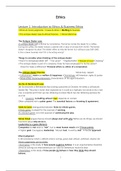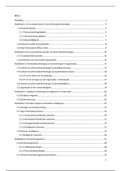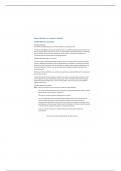W2 - Lecture prep
November 19, 2022 12:06 PM
Title: History of the monetary financial system; introduction
The Gold Standard Introduction to the Gold Standard and Bretton Woods:
(GS)
W did the money • Gold standard: system where the amount of money is kept stable with the amount of
supply depend on? gold held by the CB
• Prices are stable in the long-run (theoretically) due to the price-species
WD this mean for
long-run prices? mechanism
○ Price-species mechanism (David Hume, 1749):
Explain the price- ▪ Assumption: only gold coins are circulated (no role for other types of
species mechanism…
(draw a BS of 2 credit money, banks and CBs)
countries as in slide ▪ Illustration:
5 week 2) □ Country 1 has a trade deficit – it imports more than it exports.
This results in an outflow of gold. This decreases the amount
of money in its economy. This in turn, makes its domestic
prices fall.
□ As a consequence its goods become cheaper than foreign
goods. This leads to more exports and less imports and a
reversal of the trade deficit.
□ In a way any trade imbalance self-corrects leading to stable
prices in the long-run.
YD everyone want • Everyone is worried about how to get gold, because it is key for economic
gold?
growth
HD the hegemon • The hegemon (center country) has less pressure because even if they do have an
country have an outflow of gold to pay for goods, it comes back as capital investments
advantage?
WR the disadvantages • Disadvantages:
of the GS (2)? ○ Adjustment is contractionary
▪ Not having enough gold would cause prices to drop (deflation)
□ Deflation crises can be very severe (e.g.: 1895 in US)
▪ The burden of adjustment is on the deficit countries
□ Adjustment causes less investment and less consumption,
leading to less growth
▪ It had a positive feedback loop: it would boost growth for well-
performing economies but hamper it for non-performing
□ With more trust: less gold needed
□ With less trust: more gold needed
○ Contagion: crises would spread from one country (e.g.: Revolución del
parque in AR) to the other in the absence of a mechanism that would act
as a buffer (e.g.: exchange rates)
▪ Only countermeasure to limit gold outflows is to restrict imports,
which decreases global utility
□ The one country's imports are the other's exports. The scarcity
of gold in one country would cause it to decrease its imports,
at the expense of the profit that the exporter would have
caused. The world economy is worse off.
W was the advantage • Advantage: price stability which helped world economy grow by a large
of the GS?
expansion of world trade from 1870-1940
• In practice the system did not run on gold but on commercial paper to represent
HD the GS system run
in practice? ownership of underlying gold reserves
○ Pro: Less gold was needed to run the system because the commercial
W was the advantage paper (i.e.: gov't bonds and bills) denominated in gold would be less prone
of this?
to deflation/inflation
Global Finance and Growth Page 9
, to deflation/inflation
▪ Contractionary disadvantage could be partially avoided: if gold
stocks were running low, a CB could issue bills (denominated in gold)
which would be accepted as means of settlement by other CB
□ This way the deficit country would not necessarily have to
contract
○ Con: vulnerability of the system due to its dependence of perceived
W was the capacity of issuing institution to make good for their promises (commercial
disadvantage of this? paper).
▪ If trust diminishes, there are gold-runs (i.e.: after WWI many CB had
to impose policies of how much gold as a ratio would be kept)
□ Gold sinks: These reserves hurt the international system, as
they mean that a part of the world's gold is frozen in reserve
accounts
• Trying to go back to the Gold Standard after the WWI inflicted a lot of suffering
due to price distortions affecting international competitivity of countries
(export/import prices)
Summary:
Global Finance and Growth Page 10
, W2 - d'Arista, 2009
November 19, 2022 1:06 PM
Title: The evolving international monetary system
Introduction
• The current economic scenario raises doubts about the convenience of the current
financial and monetary architecture, incl. issues on international policy coordination
and surveillance, global governance, financing for development, and debt and crisis
management.
• Debate between potential advantages of fixed vs floating exchange rates is still
going on
○ What should be the currency for settlement of int'l transactions? This
question used be to critical for the monetary and financial architecture,
but not any more after the collapse of the Bretton Woods regime.
▪ The collapse of BW meant that international payments would be
made by private banks in the national currencies of the so-called
‘strong’ currency countries rather than exchanges of gold by central
banks.
• The dollar's dominance during the 1990s was unchallenged, as shown by: rising
dollarized debt (domestic and int'l), share of dollar-denominated assets in
international reserves holdings, amount of $ held and exchanged outside the US, and
the impact of changes in US interest rates (and value of dollar) on global economies.
• How convenient is this?
○ Argument: Any country that issues the global medium of exchange will
experience capital inflows and the resulting investments in its credit
instruments will increase the availability of credit and allow its residents to
spend more and save less.
▪ In line with Bernanke's arguments (Week 4).
○ Counterargument: the steady stream of capital inflows can only continue if
the key currency country is able or willing to run the trade deficits that
allow other countries to earn the currency they hold as international
reserves.
▪ In line with Angrick's argument (Week 3).
▪ The ballooning internal debt of the reserve currency country—
particularly of its household sector—strains its capacity to import
and undermines the value of its currency (literally and its value as
money of the world)
The historical framework
The gold standard (1870-1914)
• Acceptance of fiat (paper) monies in the 17th century (receipts for gold deposits in the
bank of Amsterdam)
• Bank notes were/are trusted because they are backed by the government (and
its ability to tax, impose tariffs and coordinate).
• Paper money is more convenient than payment in coins… So the government
backing meant a rapid adoption of paper money as a convenient alternative
during the 18th and 19th centuries.
• In the face of large funding needed for wars, the US intermittently stopped
convertibility of its paper money into gold in 1879 and 1933. In 1940, it became a fiat
currency altogether.
• In the mid 19th century, large reserves of gold were discovered (1849 in California and
1851 in Australia). Gold crowded out silver as the main means of settlement. By May
1900, Europe and the US had adopted the Gold standard.
Global Finance and Growth Page 11
November 19, 2022 12:06 PM
Title: History of the monetary financial system; introduction
The Gold Standard Introduction to the Gold Standard and Bretton Woods:
(GS)
W did the money • Gold standard: system where the amount of money is kept stable with the amount of
supply depend on? gold held by the CB
• Prices are stable in the long-run (theoretically) due to the price-species
WD this mean for
long-run prices? mechanism
○ Price-species mechanism (David Hume, 1749):
Explain the price- ▪ Assumption: only gold coins are circulated (no role for other types of
species mechanism…
(draw a BS of 2 credit money, banks and CBs)
countries as in slide ▪ Illustration:
5 week 2) □ Country 1 has a trade deficit – it imports more than it exports.
This results in an outflow of gold. This decreases the amount
of money in its economy. This in turn, makes its domestic
prices fall.
□ As a consequence its goods become cheaper than foreign
goods. This leads to more exports and less imports and a
reversal of the trade deficit.
□ In a way any trade imbalance self-corrects leading to stable
prices in the long-run.
YD everyone want • Everyone is worried about how to get gold, because it is key for economic
gold?
growth
HD the hegemon • The hegemon (center country) has less pressure because even if they do have an
country have an outflow of gold to pay for goods, it comes back as capital investments
advantage?
WR the disadvantages • Disadvantages:
of the GS (2)? ○ Adjustment is contractionary
▪ Not having enough gold would cause prices to drop (deflation)
□ Deflation crises can be very severe (e.g.: 1895 in US)
▪ The burden of adjustment is on the deficit countries
□ Adjustment causes less investment and less consumption,
leading to less growth
▪ It had a positive feedback loop: it would boost growth for well-
performing economies but hamper it for non-performing
□ With more trust: less gold needed
□ With less trust: more gold needed
○ Contagion: crises would spread from one country (e.g.: Revolución del
parque in AR) to the other in the absence of a mechanism that would act
as a buffer (e.g.: exchange rates)
▪ Only countermeasure to limit gold outflows is to restrict imports,
which decreases global utility
□ The one country's imports are the other's exports. The scarcity
of gold in one country would cause it to decrease its imports,
at the expense of the profit that the exporter would have
caused. The world economy is worse off.
W was the advantage • Advantage: price stability which helped world economy grow by a large
of the GS?
expansion of world trade from 1870-1940
• In practice the system did not run on gold but on commercial paper to represent
HD the GS system run
in practice? ownership of underlying gold reserves
○ Pro: Less gold was needed to run the system because the commercial
W was the advantage paper (i.e.: gov't bonds and bills) denominated in gold would be less prone
of this?
to deflation/inflation
Global Finance and Growth Page 9
, to deflation/inflation
▪ Contractionary disadvantage could be partially avoided: if gold
stocks were running low, a CB could issue bills (denominated in gold)
which would be accepted as means of settlement by other CB
□ This way the deficit country would not necessarily have to
contract
○ Con: vulnerability of the system due to its dependence of perceived
W was the capacity of issuing institution to make good for their promises (commercial
disadvantage of this? paper).
▪ If trust diminishes, there are gold-runs (i.e.: after WWI many CB had
to impose policies of how much gold as a ratio would be kept)
□ Gold sinks: These reserves hurt the international system, as
they mean that a part of the world's gold is frozen in reserve
accounts
• Trying to go back to the Gold Standard after the WWI inflicted a lot of suffering
due to price distortions affecting international competitivity of countries
(export/import prices)
Summary:
Global Finance and Growth Page 10
, W2 - d'Arista, 2009
November 19, 2022 1:06 PM
Title: The evolving international monetary system
Introduction
• The current economic scenario raises doubts about the convenience of the current
financial and monetary architecture, incl. issues on international policy coordination
and surveillance, global governance, financing for development, and debt and crisis
management.
• Debate between potential advantages of fixed vs floating exchange rates is still
going on
○ What should be the currency for settlement of int'l transactions? This
question used be to critical for the monetary and financial architecture,
but not any more after the collapse of the Bretton Woods regime.
▪ The collapse of BW meant that international payments would be
made by private banks in the national currencies of the so-called
‘strong’ currency countries rather than exchanges of gold by central
banks.
• The dollar's dominance during the 1990s was unchallenged, as shown by: rising
dollarized debt (domestic and int'l), share of dollar-denominated assets in
international reserves holdings, amount of $ held and exchanged outside the US, and
the impact of changes in US interest rates (and value of dollar) on global economies.
• How convenient is this?
○ Argument: Any country that issues the global medium of exchange will
experience capital inflows and the resulting investments in its credit
instruments will increase the availability of credit and allow its residents to
spend more and save less.
▪ In line with Bernanke's arguments (Week 4).
○ Counterargument: the steady stream of capital inflows can only continue if
the key currency country is able or willing to run the trade deficits that
allow other countries to earn the currency they hold as international
reserves.
▪ In line with Angrick's argument (Week 3).
▪ The ballooning internal debt of the reserve currency country—
particularly of its household sector—strains its capacity to import
and undermines the value of its currency (literally and its value as
money of the world)
The historical framework
The gold standard (1870-1914)
• Acceptance of fiat (paper) monies in the 17th century (receipts for gold deposits in the
bank of Amsterdam)
• Bank notes were/are trusted because they are backed by the government (and
its ability to tax, impose tariffs and coordinate).
• Paper money is more convenient than payment in coins… So the government
backing meant a rapid adoption of paper money as a convenient alternative
during the 18th and 19th centuries.
• In the face of large funding needed for wars, the US intermittently stopped
convertibility of its paper money into gold in 1879 and 1933. In 1940, it became a fiat
currency altogether.
• In the mid 19th century, large reserves of gold were discovered (1849 in California and
1851 in Australia). Gold crowded out silver as the main means of settlement. By May
1900, Europe and the US had adopted the Gold standard.
Global Finance and Growth Page 11










